SKODA FABIA 2016 3.G / NJ Repair Manual
Manufacturer: SKODA, Model Year: 2016, Model line: FABIA, Model: SKODA FABIA 2016 3.G / NJPages: 196, PDF Size: 31.86 MB
Page 61 of 196
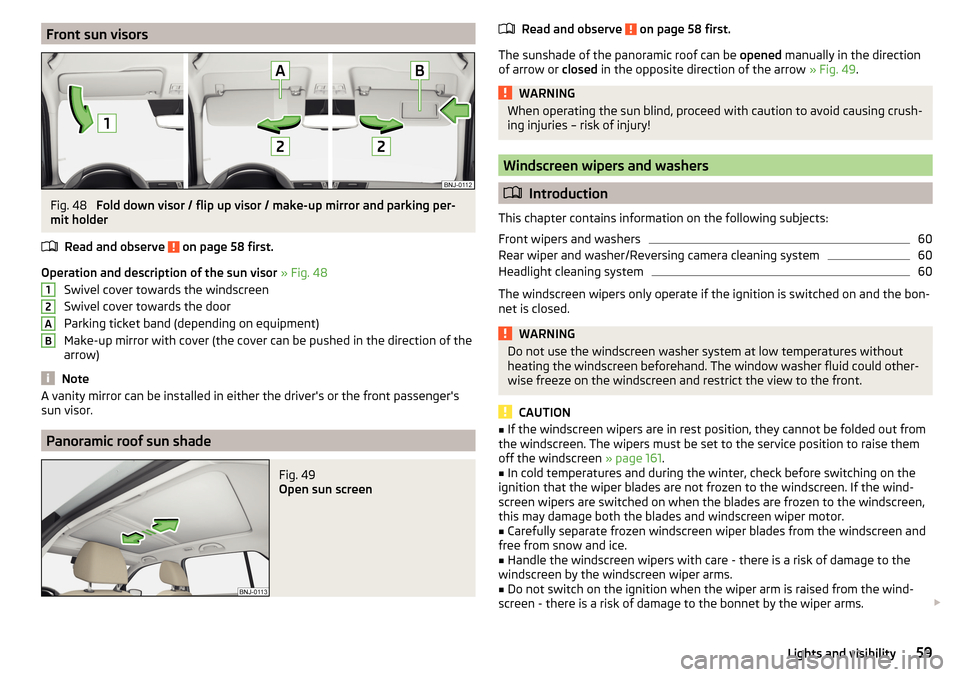
Front sun visorsFig. 48
Fold down visor / flip up visor / make-up mirror and parking per-
mit holder
Read and observe
on page 58 first.
Operation and description of the sun visor » Fig. 48
Swivel cover towards the windscreen
Swivel cover towards the door
Parking ticket band (depending on equipment)
Make-up mirror with cover (the cover can be pushed in the direction of the
arrow)
Note
A vanity mirror can be installed in either the driver's or the front passenger's
sun visor.
Panoramic roof sun shade
Fig. 49
Open sun screen
12ABRead and observe on page 58 first.
The sunshade of the panoramic roof can be opened manually in the direction
of arrow or closed in the opposite direction of the arrow » Fig. 49.
WARNINGWhen operating the sun blind, proceed with caution to avoid causing crush-
ing injuries – risk of injury!
Windscreen wipers and washers
Introduction
This chapter contains information on the following subjects:
Front wipers and washers
60
Rear wiper and washer/Reversing camera cleaning system
60
Headlight cleaning system
60
The windscreen wipers only operate if the ignition is switched on and the bon-
net is closed.
WARNINGDo not use the windscreen washer system at low temperatures without
heating the windscreen beforehand. The window washer fluid could other-
wise freeze on the windscreen and restrict the view to the front.
CAUTION
■ If the windscreen wipers are in rest position, they cannot be folded out from
the windscreen. The wipers must be set to the service position to raise them
off the windscreen » page 161.■
In cold temperatures and during the winter, check before switching on the
ignition that the wiper blades are not frozen to the windscreen. If the wind-
screen wipers are switched on when the blades are frozen to the windscreen,
this may damage both the blades and windscreen wiper motor.
■
Carefully separate frozen windscreen wiper blades from the windscreen and
free from snow and ice.
■
Handle the windscreen wipers with care - there is a risk of damage to the
windscreen by the windscreen wiper arms.
■
Do not switch on the ignition when the wiper arm is raised from the wind-
screen - there is a risk of damage to the bonnet by the wiper arms.
59Lights and visibility
Page 62 of 196
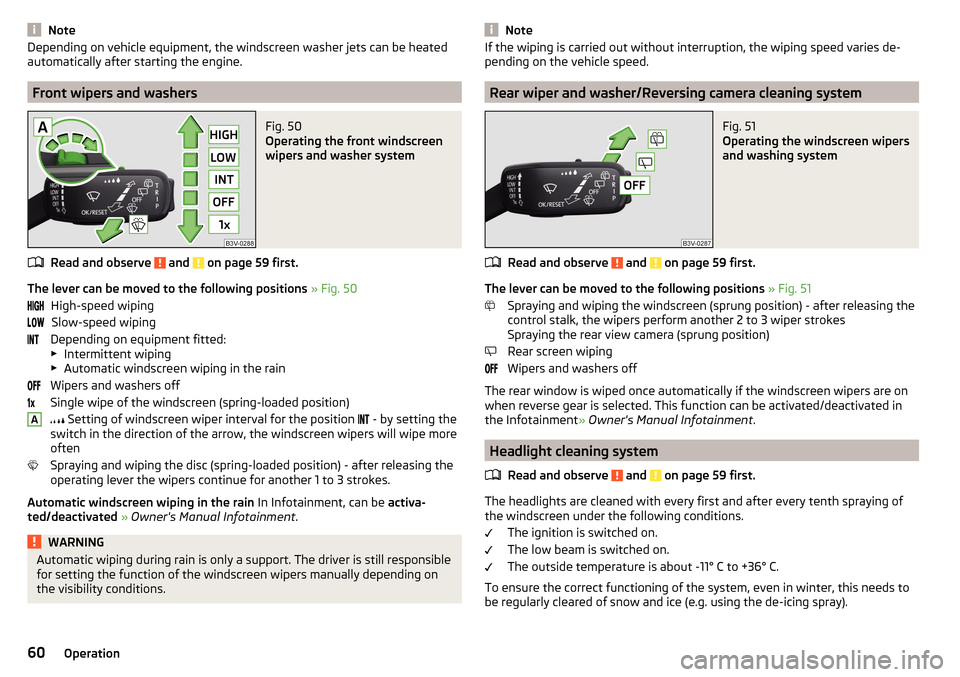
NoteDepending on vehicle equipment, the windscreen washer jets can be heated
automatically after starting the engine.
Front wipers and washers
Fig. 50
Operating the front windscreen
wipers and washer system
Read and observe and on page 59 first.
The lever can be moved to the following positions » Fig. 50
High-speed wiping Slow-speed wiping
Depending on equipment fitted:
▶ Intermittent wiping
▶ Automatic windscreen wiping in the rain
Wipers and washers off
Single wipe of the windscreen (spring-loaded position)
Setting of windscreen wiper interval for the position
- by setting the
switch in the direction of the arrow, the windscreen wipers will wipe more
often
Spraying and wiping the disc (spring-loaded position) - after releasing the
operating lever the wipers continue for another 1 to 3 strokes.
Automatic windscreen wiping in the rain In Infotainment, can be activa-
ted/deactivated » Owner's Manual Infotainment .
WARNINGAutomatic wiping during rain is only a support. The driver is still responsible
for setting the function of the windscreen wipers manually depending on
the visibility conditions. ANoteIf the wiping is carried out without interruption, the wiping speed varies de-
pending on the vehicle speed.
Rear wiper and washer/Reversing camera cleaning system
Fig. 51
Operating the windscreen wipers
and washing system
Read and observe and on page 59 first.
The lever can be moved to the following positions » Fig. 51
Spraying and wiping the windscreen (sprung position) - after releasing the
control stalk, the wipers perform another 2 to 3 wiper strokes
Spraying the rear view camera (sprung position)
Rear screen wiping
Wipers and washers off
The rear window is wiped once automatically if the windscreen wipers are on when reverse gear is selected. This function can be activated/deactivated in
the Infotainment » Owner's Manual Infotainment .
Headlight cleaning system
Read and observe
and on page 59 first.
The headlights are cleaned with every first and after every tenth spraying of
the windscreen under the following conditions.
The ignition is switched on.
The low beam is switched on.
The outside temperature is about -11° C to +36° C.
To ensure the correct functioning of the system, even in winter, this needs to be regularly cleared of snow and ice (e.g. using the de-icing spray).
60Operation
Page 63 of 196

Rear view mirror
Introduction
This chapter contains information on the following subjects:
Interior mirror dimming
61
Mirrors
61WARNINGExterior mirrors increase the field of view, however, they make objects ap-
pear smaller and further away. Therefore, use the interior mirror whenever
possible for assessing the distances to the vehicles following behind.
Interior mirror dimming
Fig. 52
Interior mirror: manual dimming/auto-darkening
Read and observe
on page 61 first.
Mirrors with manual dimming » Fig. 52 -
Basic mirror position (not darkened)
Mirror dimming
Mirror with automatic dimming
The mirror dimming » Fig. 52 -
is automatically controlled after the engine
start.
When the interior lights are switched on or the reverse gear is engaged, the
mirror moves back into the basic position (not dimmed).
12WARNING■ Attach external devices (e.g. navigation system) not in the vicinity of the
mirror with automatic dimming . The illuminated display of an external de-
vice can affect the function of the rear-view mirror - it could cause an acci-
dent.■
The automatic dimming mirror only functions smoothly if the light falling
on the sensors is not compromised (e.g. by the sunshade at the back). The
sensors are located on the front and back of the mirror.
WARNING■ The mirrors with automatic dimming contain electrolyte fluid which may
leak if the mirror glass is broken - this can irritate skin, eyes and the respi-
ratory system.■
If your eyes or skin come into contact with the electrolytic fluid, immedi-
ately wash the affected area for several minutes plenty of water. If neces-
sary get medical assistance.
Mirrors
Fig. 53
Exterior mirror operation: mechanical / electrical
Read and observe
on page 61 first.
The outer mirror surfaces are (depending on the vehicle specification) mechan-
ically or electrically adjustable.
›
To set the mirror surface, move the knob in the direction of arrows » Fig. 53.
If the electrical mirror setting fails at any time, the mirrors can be adjusted by
hand by carefully pressing on the edge of the mirror surface.
61Lights and visibility
Page 64 of 196
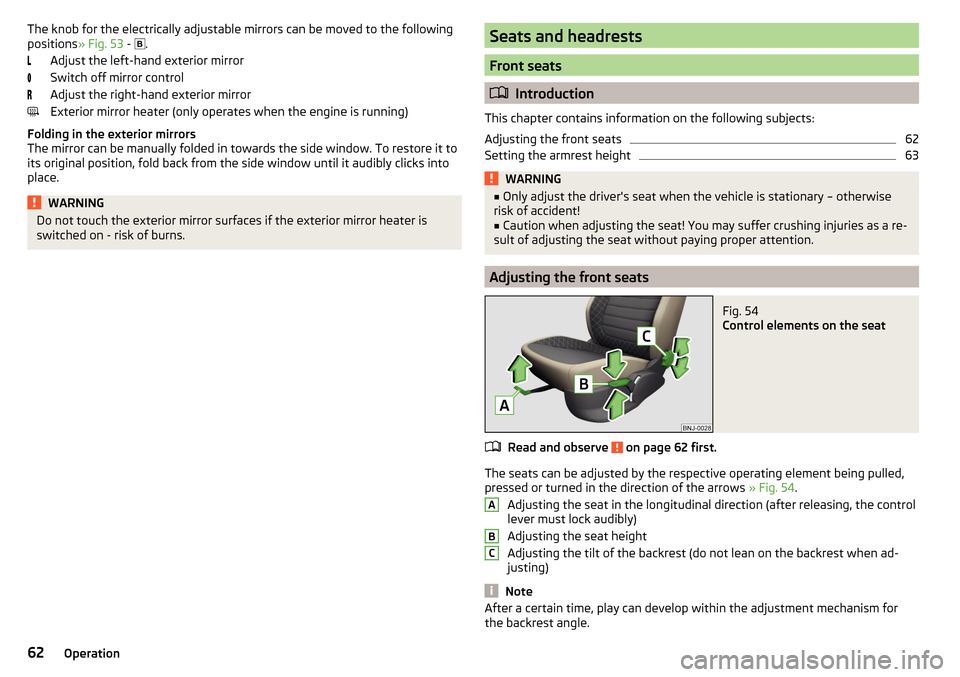
The knob for the electrically adjustable mirrors can be moved to the following
positions » Fig. 53 - .
Adjust the left-hand exterior mirror
Switch off mirror control
Adjust the right-hand exterior mirror
Exterior mirror heater (only operates when the engine is running)
Folding in the exterior mirrors
The mirror can be manually folded in towards the side window. To restore it to
its original position, fold back from the side window until it audibly clicks into
place.WARNINGDo not touch the exterior mirror surfaces if the exterior mirror heater is
switched on - risk of burns.Seats and headrests
Front seats
Introduction
This chapter contains information on the following subjects:
Adjusting the front seats
62
Setting the armrest height
63WARNING■ Only adjust the driver's seat when the vehicle is stationary – otherwise
risk of accident!■
Caution when adjusting the seat! You may suffer crushing injuries as a re-
sult of adjusting the seat without paying proper attention.
Adjusting the front seats
Fig. 54
Control elements on the seat
Read and observe on page 62 first.
The seats can be adjusted by the respective operating element being pulled,
pressed or turned in the direction of the arrows » Fig. 54.
Adjusting the seat in the longitudinal direction (after releasing, the control
lever must lock audibly)
Adjusting the seat height
Adjusting the tilt of the backrest (do not lean on the backrest when ad-
justing)
Note
After a certain time, play can develop within the adjustment mechanism for
the backrest angle.ABC62Operation
Page 65 of 196

Setting the armrest heightFig. 55
Raising the armrest
Read and observe on page 62 first.
›
To Adjusting the height , lift the armrest in the direction of the arrow into
one of the six locking positions » Fig. 55.
›
To fold down , lift the armrest in the direction of the arrow up to the stop and
then fold back down again.
Rear seats
Introduction
This chapter contains information on the following subjects:
Seat backrests
63
Rear seat
64
Seat backrests
Fig. 56
Fold seat backrest forwards / standby position of the seat belt
Before folding the seat backrests forwards, adapt the position of the front
seats in such a way that they are not damaged by the folded seat backrests.
Folding forward›
Push the headrest into the seat backrest up to the latch.
›
Pull the outer seat belt to the side panel in the direction of arrow
1
» Fig. 56 .
›
Push the release lever
A
in the direction of arrow
2
and fold down the seat
backrest in the direction of arrow
3
.
Withthe undivided backrest, the two external security belts must be pulled to-
wards the side panel and the release handles
A
to press on both sides of the
backrest simultaneously.
Folding backwards
›
Pull the outer seat belt to the side panel in the direction of arrow
1
» Fig. 56 .
›
Raise the seat backrest against the direction of arrow
3
until the release
handle
A
audibly locks. Check this by pulling on the seat backrest.
›
Make sure that the red pin
B
is hidden.
In the undivided seat back, pull the two outer belts to the side panel. After
folding back the backrest, the release handles
A
should audibly click into
place on both sides of the backrest and the red mark
B
should not be visible
on either side of the backrest.
WARNING■ The seat backs in occupied rear seats must be properly engaged.■When transporting objects in the luggage compartment that has been en-
larged by folding the backrest forward, ensure the safety of the passengers
transported on the other rear seats.■
The seat backrests must be securely latched in position so that no ob-
jects from the luggage compartment can slip into the passenger compart-
ment under sudden braking – risk of injury.
CAUTION
When moving the seat backrest the seat belts should not be trapped - there is
a risk of damage to the seat belts.
Note
The belt tongue of the outer seat belts C can be inserted into the side panel.
Ready position » Fig. 56.63Seats and headrests
Page 66 of 196
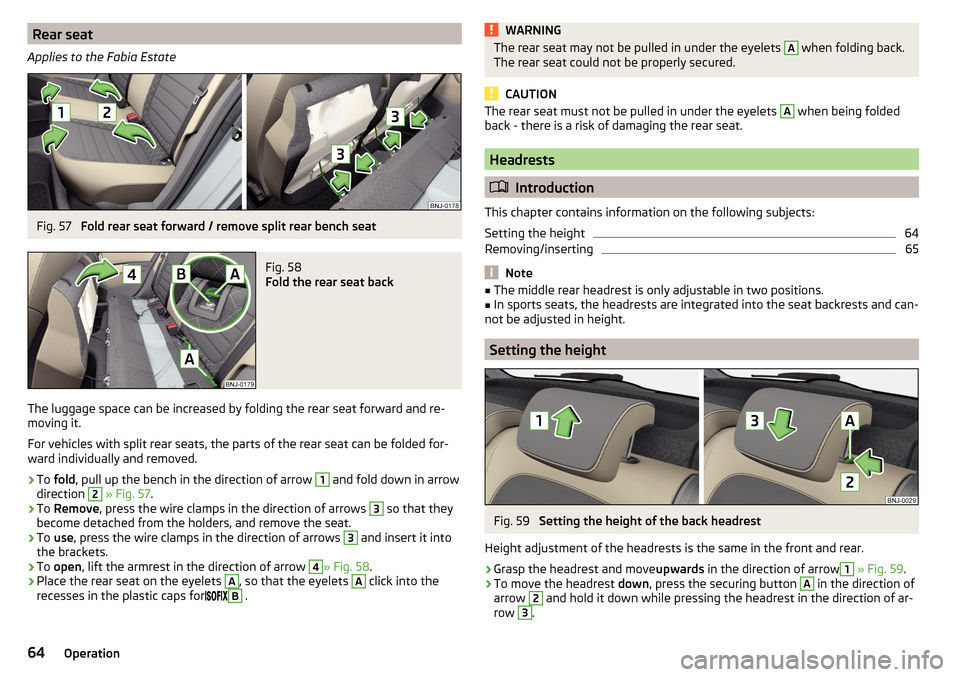
Rear seat
Applies to the Fabia EstateFig. 57
Fold rear seat forward / remove split rear bench seat
Fig. 58
Fold the rear seat back
The luggage space can be increased by folding the rear seat forward and re-
moving it.
For vehicles with split rear seats, the parts of the rear seat can be folded for-
ward individually and removed.
›
To fold , pull up the bench in the direction of arrow
1
and fold down in arrow
direction
2
» Fig. 57 .
›
To Remove , press the wire clamps in the direction of arrows
3
so that they
become detached from the holders, and remove the seat.
›
To use , press the wire clamps in the direction of arrows
3
and insert it into
the brackets.
›
To open , lift the armrest in the direction of arrow
4
» Fig. 58 .
›
Place the rear seat on the eyelets
A
, so that the eyelets
A
click into the
recesses in the plastic caps for
B
.
WARNINGThe rear seat may not be pulled in under the eyelets A when folding back.
The rear seat could not be properly secured.
CAUTION
The rear seat must not be pulled in under the eyelets A when being folded
back - there is a risk of damaging the rear seat.
Headrests
Introduction
This chapter contains information on the following subjects:
Setting the height
64
Removing/inserting
65
Note
■ The middle rear headrest is only adjustable in two positions.■In sports seats, the headrests are integrated into the seat backrests and can-
not be adjusted in height.
Setting the height
Fig. 59
Setting the height of the back headrest
Height adjustment of the headrests is the same in the front and rear.
›
Grasp the headrest and move upwards in the direction of arrow
1
» Fig. 59 .
›
To move the headrest down, press the securing button
A
in the direction of
arrow
2
and hold it down while pressing the headrest in the direction of ar-
row
3
.
64Operation
Page 67 of 196
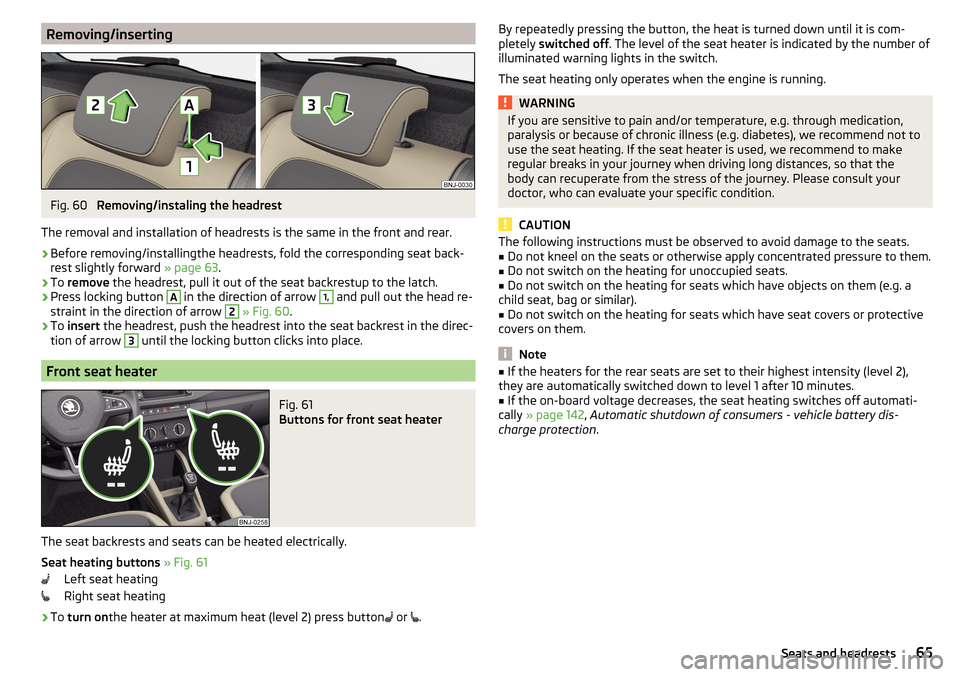
Removing/insertingFig. 60
Removing/instaling the headrest
The removal and installation of headrests is the same in the front and rear.
›
Before removing/installingthe headrests, fold the corresponding seat back-
rest slightly forward » page 63.
›
To remove the headrest, pull it out of the seat backrestup to the latch.
›
Press locking button
A
in the direction of arrow
1,
and pull out the head re-
straint in the direction of arrow
2
» Fig. 60 .
›
To insert the headrest, push the headrest into the seat backrest in the direc-
tion of arrow
3
until the locking button clicks into place.
Front seat heater
Fig. 61
Buttons for front seat heater
The seat backrests and seats can be heated electrically.
Seat heating buttons » Fig. 61
Left seat heating
Right seat heating
›
To turn on the heater at maximum heat (level 2) press button
or
.
By repeatedly pressing the button, the heat is turned down until it is com-
pletely switched off . The level of the seat heater is indicated by the number of
illuminated warning lights in the switch.
The seat heating only operates when the engine is running.WARNINGIf you are sensitive to pain and/or temperature, e.g. through medication,
paralysis or because of chronic illness (e.g. diabetes), we recommend not to
use the seat heating. If the seat heater is used, we recommend to make
regular breaks in your journey when driving long distances, so that the
body can recuperate from the stress of the journey. Please consult your
doctor, who can evaluate your specific condition.
CAUTION
The following instructions must be observed to avoid damage to the seats.■Do not kneel on the seats or otherwise apply concentrated pressure to them.■
Do not switch on the heating for unoccupied seats.
■
Do not switch on the heating for seats which have objects on them (e.g. a
child seat, bag or similar).
■
Do not switch on the heating for seats which have seat covers or protective
covers on them.
Note
■ If the heaters for the rear seats are set to their highest intensity (level 2),
they are automatically switched down to level 1 after 10 minutes.■
If the on-board voltage decreases, the seat heating switches off automati-
cally » page 142 , Automatic shutdown of consumers - vehicle battery dis-
charge protection .
65Seats and headrests
Page 68 of 196

Useful features
Interior fittings
Introduction
This chapter contains information on the following subjects:
Ticket holder
66
Storage compartments in the doors
67
Storage compartment in the front centre console
67
USB and AUX input
67
Coin and card holders
67
Storage compartment on the dash panel
68
Cup holders
68
Waste container
68
Cigarette lighter
69
Ashtray
69
12-volt power outlet
70
Multimedia holder
70
Storage compartment in the front arm rest
71
Glasses compartment
71
Storage compartment on the front passenger side
71
Storage compartment on the side of front seat
72
storage compartment under the passenger seat
72
Storage compartment for umbrella
72
Clothes hook
72
Storage pockets on the backs of the front seats
73
Storage pockets on the inner sides of the front seats
73
Storage compartment in the rear centre console
73WARNING■ Do not place anything on the dash panel. These objects might slide or fall
down when driving and may distract you from concentrating on the traffic –
risk of accident!■
Make sure that while driving no objects can enter the driver's footwell -
they could cause an accident!
WARNING (Continued)■ Do not transport any objects on the front passenger seat other than ob-
jects intended for this purpose (e.g. child safety seat) – risk of accident.■
No objects should be placed in the storage compartments nor in the
drinks holders; the vehicle occupants could be endangered if there is sud-
den braking or the vehicle collides with something.
■
For safety reasons, lockable storage compartments should be closed
while driving - there is a risk of injury from the opened lid or through the
loose objects in the compartment.
■
Make sure no objects protrude from the storage compartments - There is
a risk of injury!
■
Do not exceed the permissible loads for the storage compartments and
pockets - risk of injury and risk of damage to the compartments and pock-
ets!
■
Ash, cigarettes, cigars etc. should only be stored in the ashtray - danger
of fire/burns!
■
The storage compartments, multimedia holder and waste container are
not a substitute for the ashtray and must not be used for such purposes –
risk of fire!
CAUTION
Do not place any large or sharp objects in the storage compartments and pock-
ets - there is a risk of damage to the compartments and pockets.
Ticket holder
Fig. 62
Ticket holder
Read and observe and on page 66 first.
The ticket holder » Fig. 62 is provided for the holding and displaying e.g. car
park tickets.
66Operation
Page 69 of 196
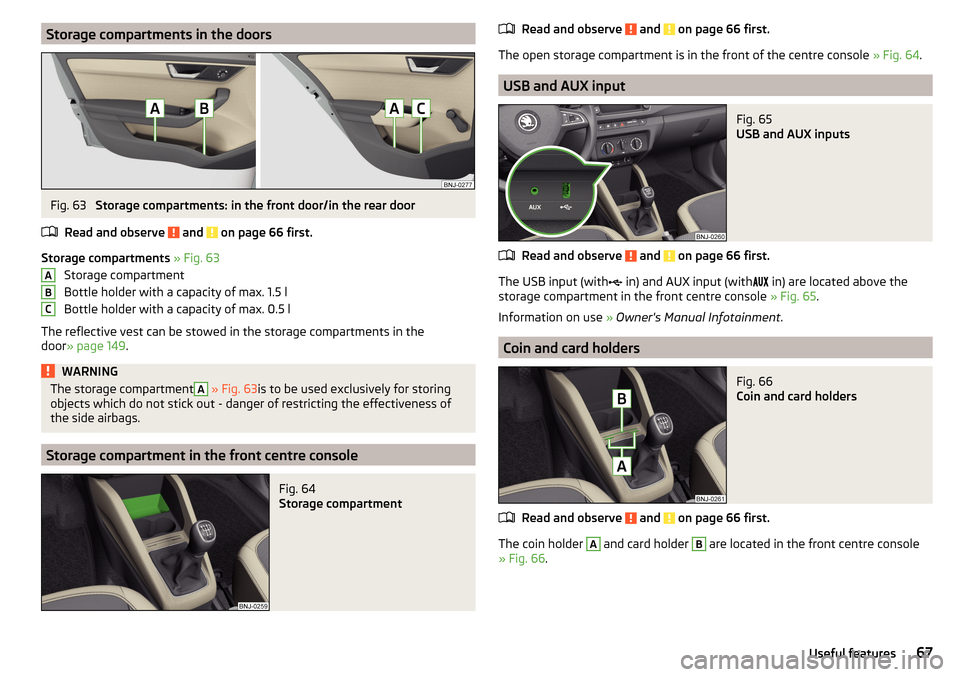
Storage compartments in the doorsFig. 63
Storage compartments: in the front door/in the rear door
Read and observe
and on page 66 first.
Storage compartments » Fig. 63
Storage compartment
Bottle holder with a capacity of max. 1.5 l
Bottle holder with a capacity of max. 0.5 l
The reflective vest can be stowed in the storage compartments in the
door » page 149 .
WARNINGThe storage compartmentA » Fig. 63 is to be used exclusively for storing
objects which do not stick out - danger of restricting the effectiveness of
the side airbags.
Storage compartment in the front centre console
Fig. 64
Storage compartment
ABCRead and observe and on page 66 first.
The open storage compartment is in the front of the centre console » Fig. 64.
USB and AUX input
Fig. 65
USB and AUX inputs
Read and observe and on page 66 first.
The USB input (with
in) and AUX input (with
in) are located above the
storage compartment in the front centre console » Fig. 65.
Information on use » Owner's Manual Infotainment .
Coin and card holders
Fig. 66
Coin and card holders
Read and observe and on page 66 first.
The coin holder
A
and card holder
B
are located in the front centre console
» Fig. 66 .
67Useful features
Page 70 of 196
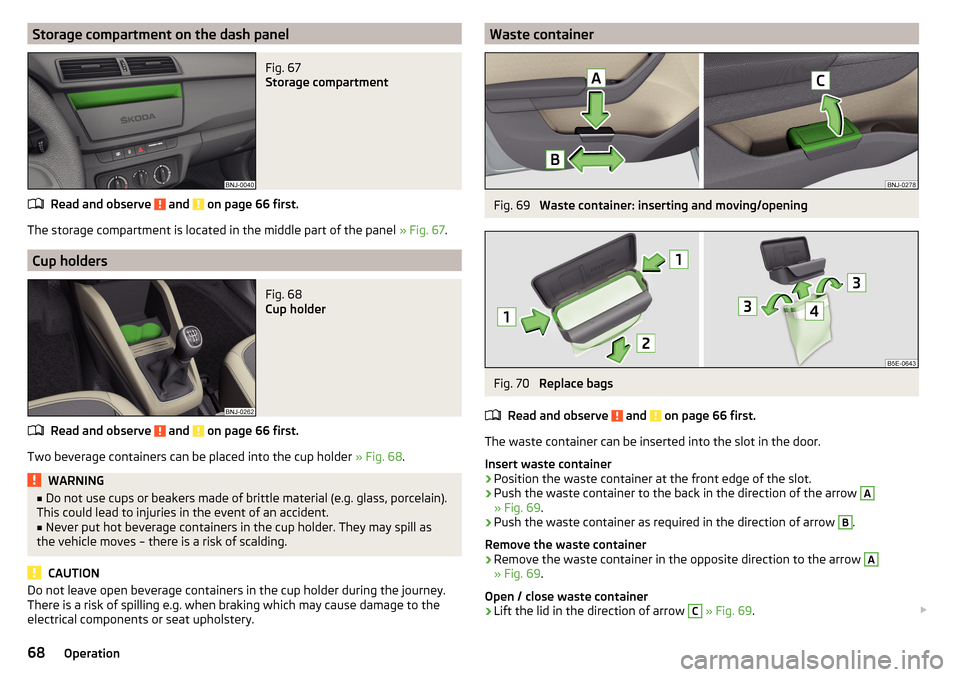
Storage compartment on the dash panelFig. 67
Storage compartment
Read and observe and on page 66 first.
The storage compartment is located in the middle part of the panel » Fig. 67.
Cup holders
Fig. 68
Cup holder
Read and observe and on page 66 first.
Two beverage containers can be placed into the cup holder » Fig. 68.
WARNING■
Do not use cups or beakers made of brittle material (e.g. glass, porcelain).
This could lead to injuries in the event of an accident.■
Never put hot beverage containers in the cup holder. They may spill as
the vehicle moves – there is a risk of scalding.
CAUTION
Do not leave open beverage containers in the cup holder during the journey.
There is a risk of spilling e.g. when braking which may cause damage to the
electrical components or seat upholstery.Waste containerFig. 69
Waste container: inserting and moving/opening
Fig. 70
Replace bags
Read and observe
and on page 66 first.
The waste container can be inserted into the slot in the door.
Insert waste container
›
Position the waste container at the front edge of the slot.
›
Push the waste container to the back in the direction of the arrow
A
» Fig. 69 .
›
Push the waste container as required in the direction of arrow
B
.
Remove the waste container
›
Remove the waste container in the opposite direction to the arrow
A
» Fig. 69 .
Open / close waste container
›
Lift the lid in the direction of arrow
C
» Fig. 69 .
68Operation